The Lenovo ThinkPad X1 Yoga Review: OLED and LCD Tested
by Brett Howse & Brandon Chester on September 29, 2016 11:30 AM ESTDesign
The ThinkPad brand is well established, and Lenovo is not making any dramatic changes with aesthetics. They’ve focused on thin and light, and that is what the X1 Yoga provides. The notebook has a carbon fibre weave in the top lid, but all of the surfaces are the normal matte black finish of ThinkPads. It would be nice to see them offer a model with a metal finish, but the metal is on the inside with a magnesium alloy frame which Lenovo refers to as 'Super Mag'. It makes the laptop plenty sturdy despite the thin nature.
The hinge is a new design, allowing for a thinner and lighter hinge, and the hinge is metal for durability. For flip around convertibles like this, the hinge is very important to get right - too stiff will make for a difficult to open laptop, and too loose will mean that the screen will have excessive bounce when using it in a touch mode. Lenovo has hit a nice balance though, with a sturdy enough hinge for a bit less bounce. Being that it opens 360° degrees, it allows a quick switch between laptop mode, stand mode, tent mode, and tablet mode. The Yoga style hinge makes for a better laptop than the detachable notebooks, with the correct weight balance when using it as a laptop. They are also much quicker to transition into other modes than detachable models, and are my preferable choice for a 2-in-1.
ThinkPads are known for having a positive keyboard user experience, and despite the thin design they’ve not forgotten about this. Although there is not a lot of travel, the key feel is quite good, and there is nice resistance on the keys. The keyboard itself is a six-row model that is spill-resistant and backlit with white LEDs. As is typical of ThinkPads, the Fn key and Ctrl key are reversed compared to other brands, but they can be switched in the system BIOS if you prefer it the other way. The arrow keys are smaller than the others, but they are all the same size and not as bunched up together as some devices. They also include a Page Up and Page Down with the arrow keys, which is a nice design for a small laptop.
One of the interesting things that the ThinkPad Yogas do, including this new X1 Yoga, is to offer a lift-and-lock keyboard. When using the laptop in any of the touch modes, the keyboard surround lifts around the keys, locking them in place. It makes for a nice feel when using the device with touch, and prevents the floppy keys from distracting you when using it as a tablet. I’m not sure how much weight or cost that adds to the X1 Yoga, but it is completely worth it.
For pointer input, Lenovo keeps the traditional TrackPoint as well as a glass touchpad. The touchpad has a good feel, and works well enough. I prefer the TrackPoint though for extra precision and ease of use. The TrackPoint seems to be a love it or never use it affair, but for long-time customers of ThinkPads, I think it needs to be there so I’m glad they still include it. Although the TrackPoint buttons do limit the touchpad size, the trade-off is still a good one.
Lenovo has offered fingerprint readers for a long time on ThinkPads, but it’s nice to see them move from the swipe model to a capacitive touch version. It’s much easier to use, since you just drop your finger on it, and accuracy and speed have been excellent.
The other thing worth discussing is the stylus, called the ThinkPad Pen Pro. Not only does Lenovo offer a stylus which works natively with Windows 10’s inking input, they also offer their own WRITEit software which further enhances the stylus support. Windows 10’s default inking experience offers a text box at the bottom of the screen which you can use to write in, but the WRITEit software lets you just write directly in any text field. It also offers gestures like delete (by striking through text), insert, tab, and more.
The Stylus hardware is from Wacom, and it’s an Active Capacitive technology so it does not require a digitizer. It still offers 2048 levels of pressure sensitivity, and includes two buttons for left and right click, although they are pretty small. The pen is powered by a super-capacitor, and to get 100 minutes of use out of the pen only takes 15 seconds inside the charging dock. Palm rejection seems to work pretty well, and although the stylus is too small to be used for artistry, as a quick writing tool it works well.
The ThinkPad X1 Yoga’s design is an evolution of the ThinkPads before it, which seems to be exactly what they were aiming for. The thin and light design is still strong, and they keyboard is very good for such a thin laptop. Lenovo has done a good job of minimizing the display bezels, but keeping enough bezel to make it usable as a tablet, and the Yoga hinge is still one of the best 2-in-1 designs on the market.


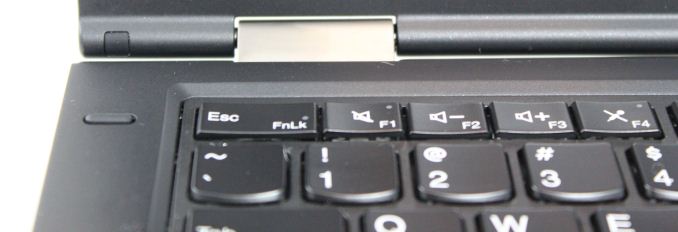
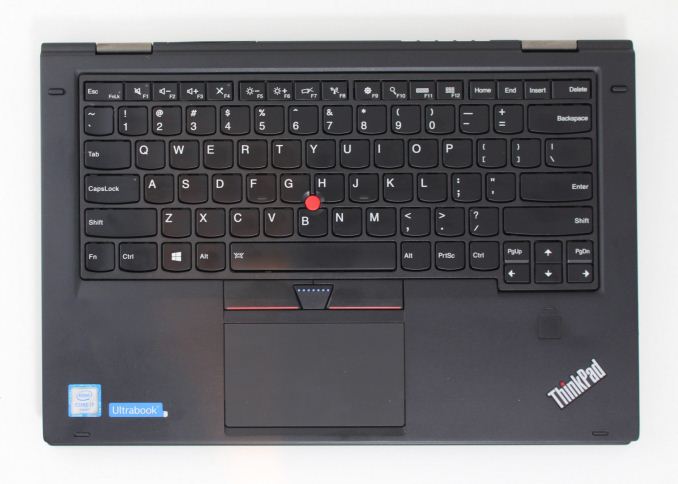
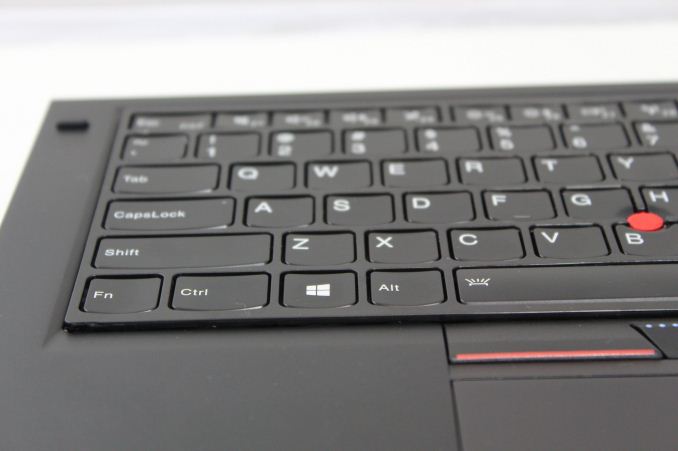
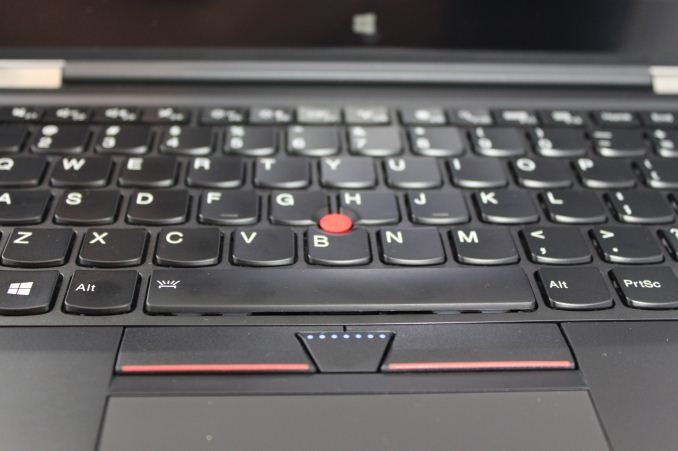
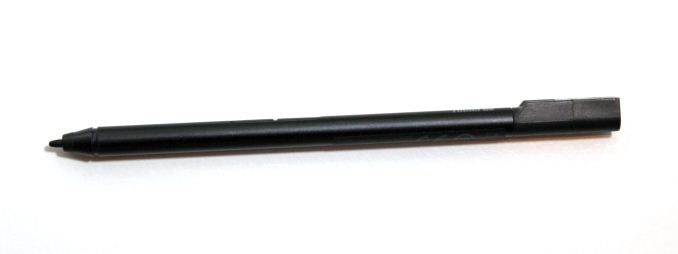








84 Comments
View All Comments
Ej24 - Thursday, September 29, 2016 - link
Nope. There are at least two or three 15w "U" processors with Iris 540 and one 28w U processor with iris 550. The 580 graphics are only reserved for HQ (35-45w) and S (65w) processors. I'd love just to have iris 540. The typical 520, 4400, or 4000 Intel graphics are hardly good enough for light gaming at 720 or heavier loads during hardware decode/encode or the 50/50 software hardware hybrid pipelines Intel has been using.Ro_Ja - Thursday, September 29, 2016 - link
All of the GeForce with *40 and below are just a waste of good money now since the Iris HD 580 can stack up against even a 940M. I can hardly find a laptop in our country without any horrible AMD EXO Pros and NVIDIA's crappy entry-level cards. I just want less heat on the laptop I want to use.spikebike - Friday, September 30, 2016 - link
I have a NUC with the Iris 540. It's pretty nice, handles the occasional light gaming, WebGL games, Minecraft, http://slither.io, and related much better than the non-iris graphics.forgot2yield28 - Friday, September 30, 2016 - link
CAD. Not a huge niche, but Iris will outperform standard intel integrated GPU. Sometimes architects/engineers want to get work done on the road. The small footprint and lightweight of an ultrabook still has appeal.Byte - Thursday, September 29, 2016 - link
Would love to get this, but all the Yogas i've had had tons of hardware bugs that were near impossible to fix. Just getting the touchpad right took a few days of fiddling. If only they can get things working.Samus - Thursday, September 29, 2016 - link
Working in IT, I can back you up on one thing for sure. These machines are hell to work on. I've had to replace two fans in Thinkpad Yoga 12.5's and they are, in traditional Lenovo fashion, not detachable from the heat pipe (which is why they failed in the first place...the bearing is in direct-contact with the source) so the whole assembly needs to be needlessly replaced, instead of just popping the cover off with a latch and unscrewing two screws like you do in just about any modern HP Elitebook.The real insult to the Thinkpad Yoga line is the dreaded history of the battery "non-recall" that caused the Yoga 14 machines to hard power off if bumped in the front right corner where the battery is connected. This connection is very sensitive and the only way we found to help prevent this anomaly was to insulate the battery connection internally on every model we came across.
Routine repair by Lenovo would result in a machine returned with the same exact problems. Dealing with Lenovo support is like dealing with a car dealership. They don't listen to your problem and the mechanic runs their standard tests, says its ok, and returns it to the customer. They don't seem to have a system in place to diagnose specific issues.
Brett Howse - Thursday, September 29, 2016 - link
It already throttles GT2. Going to GT3e would help because of eDRAM but likely throttle even more.ajp_anton - Friday, September 30, 2016 - link
Sure it throttles, nobody would expect an Iris 540 to go full speed at 15W. But with double the EUs and half the frequency, you get the same performance but at lower power (lower frequency allows for lower voltage). Wider GPUs generally have higher performance per watt because of this, at the expense of higher cost.Senti - Thursday, September 29, 2016 - link
I expect USB type-C in what you call "premium notebook" today. And better than Intel HD 520 graphics...It's sad to see that OLEDs are still "not quite ready". Battery life with web browsing was the last nail in the coffin.
BrokenCrayons - Thursday, September 29, 2016 - link
It's not bad hardware, but it does seem overpriced. Given the GPU choice, the panel resolution is too high for the graphics card to effectively drive it. 1080p is a stretch for the 520 doing anything intensive. Lenovo should offer a lower resolution & cheaper option. I can't see the usefulness of the hinge design either. Desktop operating systems work a lot better with access to a keyboard and mouse (or touchpad) so owners are probably paying for a novelty feature they'll rarely put to use.